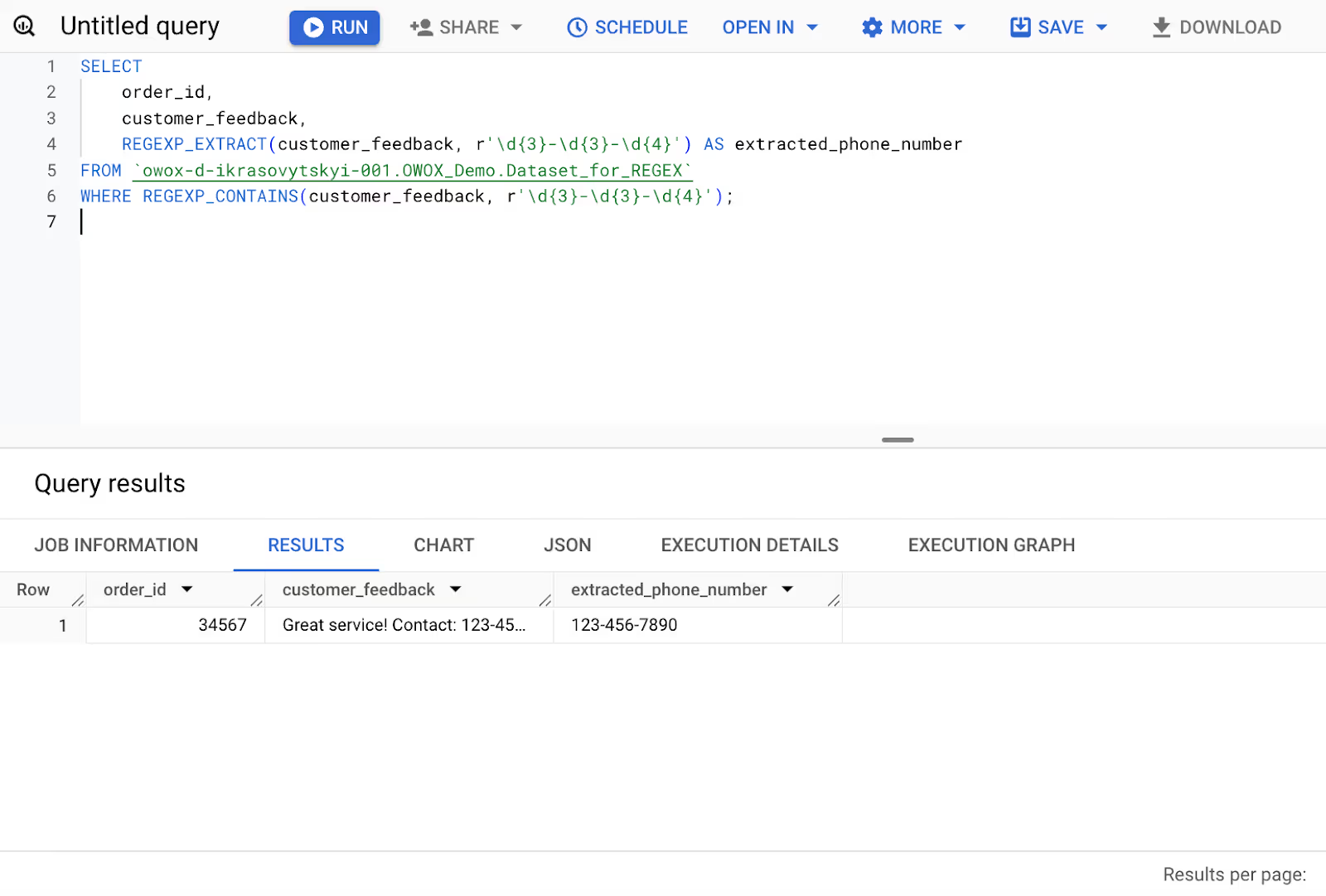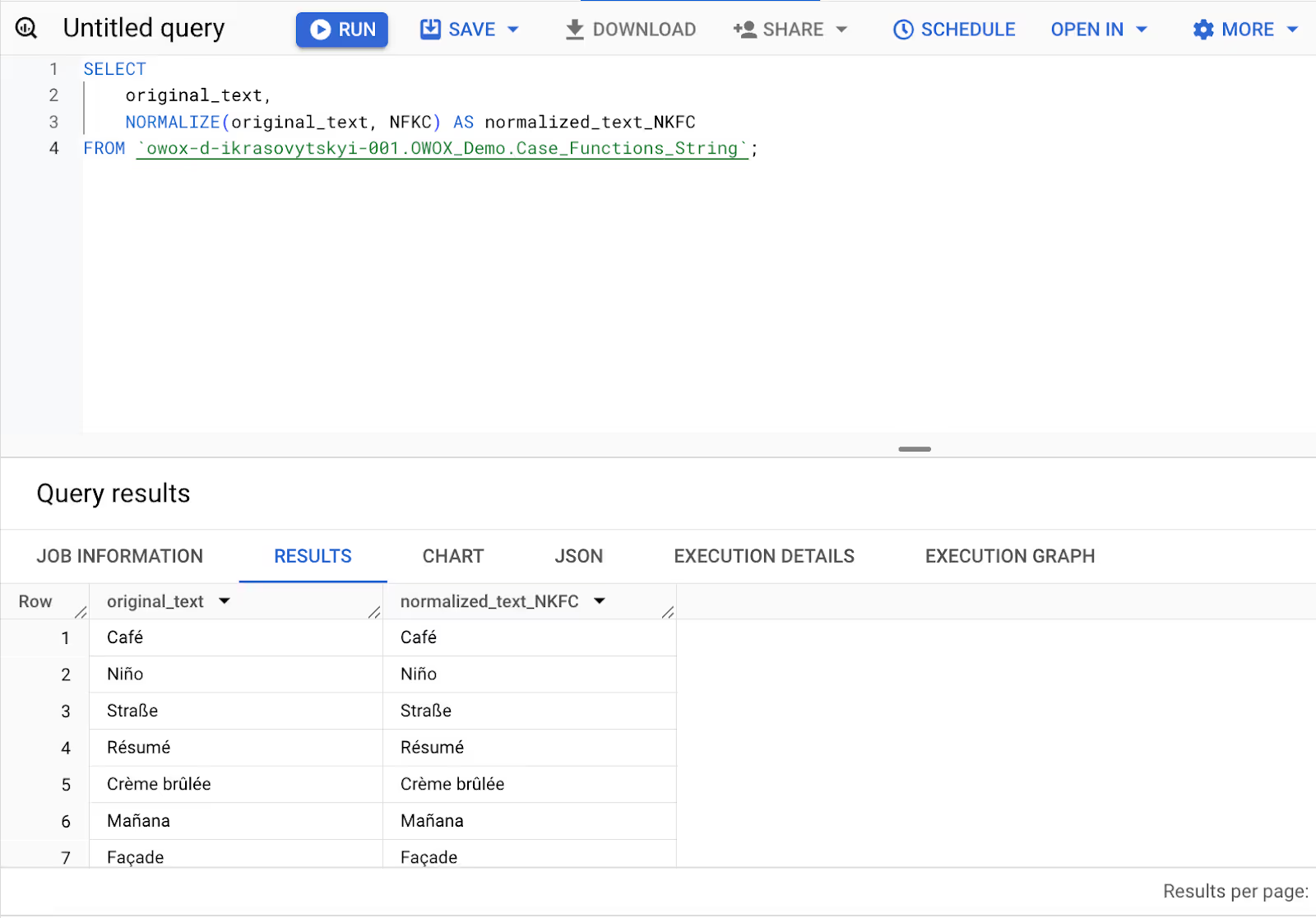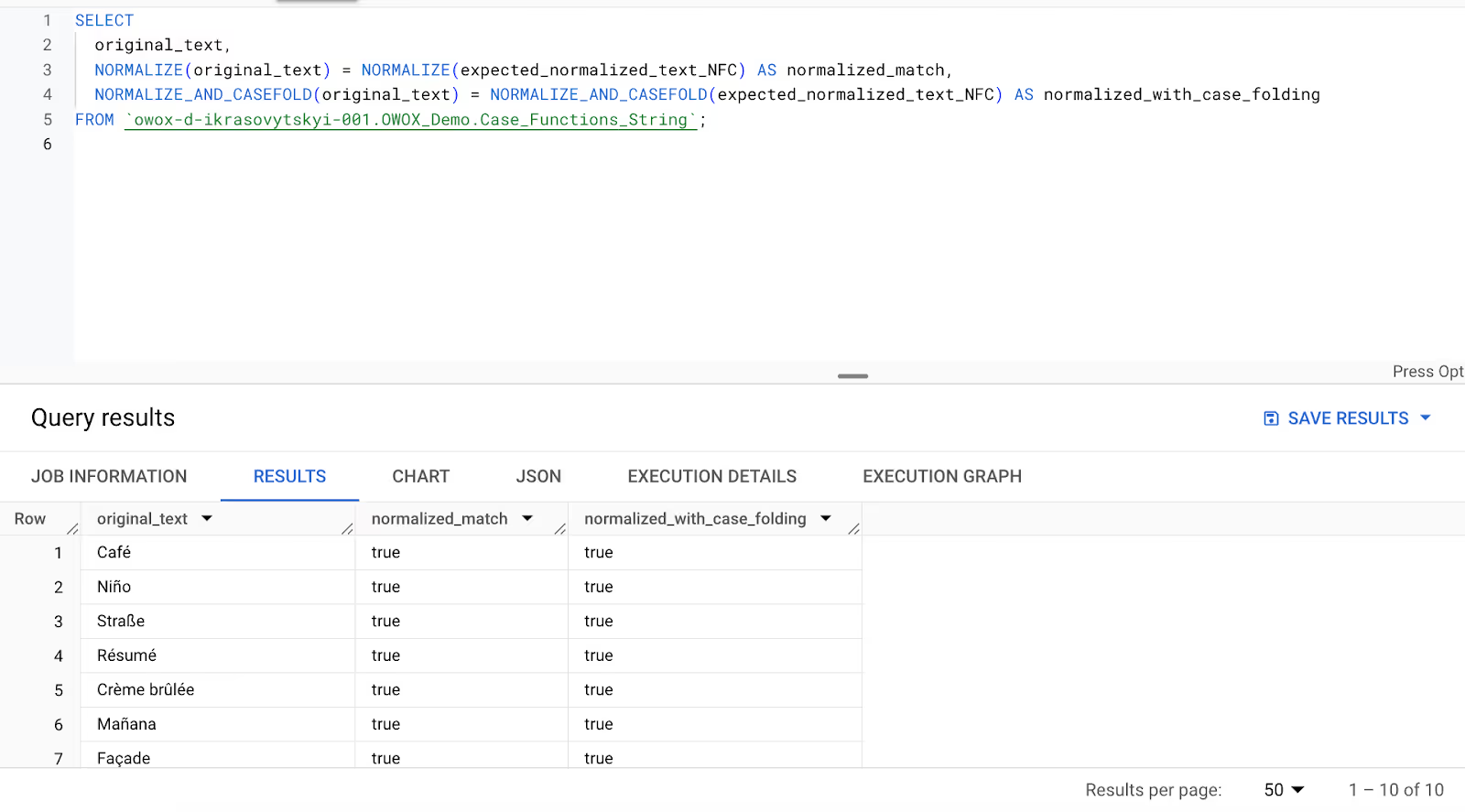Welcome to our deep dive into BigQuery’s String functions. If you’re a data analyst, SQL developer, or anyone in between who works with BigQuery data, which handles both text and numeric values, you’ve landed in the right place.

We’re not just brushing the surface here; we’re tunneling into the rich world of string manipulation functions such as TRIM, SUBSTRING, REPLACE, and REGEXP_EXTRACT to explore how they can transform your data analysis and reporting. Whether you want to find a character in a string, replace text with another string, or work with multiline strings, these functions have you covered.
For further details, examples, and best practices on BigQuery string functions, including REGEXP_CONTAINS, LPAD, be sure to consult the official documentation, which provides comprehensive explanations. Let’s start this journey together, shall we?
At the heart of BigQuery’s power is a bunch of string functions. These functions operate on various string types, such as STRING and BYTES, and understanding the appropriate string function for each type is essential. These functions are essential for data preparation, allowing you to clean, modify, and analyze your data effectively.
Whether you’re trimming whitespace, changing cases, or extracting specific data points, understanding these functions is your first step toward mastering BigQuery’s full potential. It is important to note that STRING values must be well-formed UTF-8, ensuring compatibility and proper functioning of these string operations.

In this section, we’re going beyond the basics to explore the power and flexibility of BigQuery’s string functions. Many BigQuery string functions can operate on both STRING and BYTES data types, and input values for these functions must be of the same type to avoid errors.
By understanding the syntax and seeing these functions in action through examples, you’ll be equipped to handle a wide range of data manipulation tasks. These examples are designed to be both informative and easily applicable, enabling you to refine your data with precision and efficiency.
Removing unnecessary characters from your data can significantly improve its quality and usability. BigQuery provides several functions to help you clean and prepare your data, by operating on string values. For example, the LTRIM function removes leading characters from the beginning of a string, while RTRIM removes trailing characters from the end—not just whitespace, but any specified characters. If the input is an empty string, these functions will return an empty string as well. Whether you’re dealing with unwanted spaces or trimming text to meet specific formatting requirements, these functions are indispensable tools in your data manipulation toolkit. Let’s look at how to use them effectively, with clear syntax and practical examples.
The TRIM function is used to remove whitespace from both ends of a string, cleaning up the data for further analysis. In addition to whitespace, TRIM can also be used to remove specific leading and trailing characters by specifying which characters to trim.
TRIM Syntax:
TRIM(string)
TRIM Example:
SELECT
TRIM(" hello world ") AS examplereturns “hello world”, eliminating leading and trailing spaces to tidy up your data.

The LTRIM function specifically removes whitespace from the beginning (leading side) of a string, useful for left text alignment. Beyond trimming whitespace, LTRIM can remove any specified leading characters from a string.
LTRIM Syntax:
LTRIM(string)LTRIM Example:
SELECT
LTRIM(" hello world ") AS exampleyields “hello world ”, removing only the leading space and keeping the text properly aligned to the left.

The RTRIM function eliminates whitespace from the end (trailing side) of a string, ensuring the string finishes neatly. In addition to whitespace, RTRIM can remove any specified trailing characters from the end of a string.
RTRIM Syntax:
RTRIM(string)
RTRIM Example:
SELECT
RTRIM(" hello world ") AS exampleproduces “ hello world”, targeting and removing only the trailing space to ensure precise string endings.

In Google BigQuery, there are these handy tools called SQL functions that let you spruce up text data by adding characters and spaces. Think of it like giving your data a little makeover, making it easier on the eyes and better organized for when you need to dig into it for analysis or whip up reports.
The LPAD function is used to add specified characters to the left side of a string until it reaches a certain length.
LPAD Syntax:
LPAD(string, length, pad_string)
LPAD Example:
SELECT
LPAD("hello", 8, "x") AS examplereturns "xxxhello". This syntax pads the string "hello" with "x" on the left to create a fixed length of 8 characters.

Exact opposite of the LPAD function, the RPAD function adds specified characters to the right side of a string to achieve a desired length.
RPAD Syntax:
RPAD(string, length, pad_string)
RPAD Example:
SELECT
RPAD("hello", 8, "x") AS exampleyields "helloxxx", adding "x" on the right to ensure the string reaches a total length of 8 characters, ideal for text alignment and formatting.

The REPEAT function in Google BigQuery is used to replicate a given string a certain number of times, creating a new string that consists of the original string repeated sequentially, which is useful for generating patterns or extending text dynamically within a query.
REPEAT Syntax:
REPEAT(string, number)
REPEAT Example:
SELECT
REPEAT("hello", 3) AS exampleproduces "hellohellohello", repeating the string "hello" three times, effectively multiplying the data as needed.

Manipulating the case of text in BigQuery is straightforward and highly effective for data normalization. These functions handle alphabetic characters by converting them to either lowercase or uppercase, ensuring consistent case formatting.
Whether you're dealing with user-generated content, product names, or any dataset where case consistency is required, these functions are indispensable tools. Leveraging these functions streamlines your data processing tasks, making your analysis more efficient and your reports more polished.
The UPPER function in Google BigQuery changes all the letters in a string to uppercase, making it easy to match or compare texts without worrying about letter cases.
UPPER Syntax:
UPPER(string)
UPPER Example:
SELECT
UPPER("hello") AS examplereturns "HELLO". This transformation facilitates case-sensitive comparisons by ensuring uniformity in the case.

The LOWER function in Google BigQuery turns every letter in a string to lowercase, helping to standardize text data and simplify comparisons by removing case differences.
LOWER Syntax:
LOWER(string)
LOWER Example:
SELECT
LOWER("HELLO") AS exampleyields "hello", achieving consistency in your dataset by normalizing the case of your text.

The INITCAP function in Google BigQuery makes the first letter of each word in a string uppercase and the rest lowercase, perfect for fixing titles or names to look neat and properly formatted.
INITCAP Syntax:
INITCAP(string)
INITCAP Example:
SELECT
INITCAP("hello world") AS exampleproduces “Hello World”, perfect for formatting titles and names by ensuring each word starts with a capital letter.

The REVERSE function, which is used to reverse the characters in a string. This can be particularly useful in scenarios where you need to perform operations such as palindrome checking or simply need the reverse of a string for analysis purposes.
Suppose you have a simple string, and you want to reverse it.
REVERSE Syntax:
REVERSE(string)REVERSE Example:
SELECT
REVERSE('Hello, World!') AS reversed_string;In this example, the REVERSE function takes the string 'Hello, World!' and returns '!dlroW ,olleH'.
BigQuery gives you tools like CONTAINS_SUBSTR, STRPOS, and REGEXP functions to easily search, pull out, or swap parts of your text. Functions such as INSTR and REGEXP_INSTR can be used to find the first occurrence of a substring or pattern, and the search returns the position of the match. Additionally, REGEXP_CONTAINS can be used to identify partial matches within text data.
Determines if a substring exists within a string, simplifying the identification of specific patterns or words. This method is useful for finding specific words or patterns in text, making it easier to filter data, check for certain information, or categorize text based on keywords.
CONTAINS_SUBSTR Syntax:
CONTAINS_SUBSTR(string, substring)
CONTAINS_SUBSTR Example:
SELECT
CONTAINS_SUBSTR("Data analysis in BigQuery", "BigQuery") AS examplereturns TRUE, indicating the presence of "BigQuery" within the string "Data analysis in BigQuery".

The STRPOS function in Google BigQuery helps find the exact location of a substring within a string, which is crucial for tasks like analyzing text patterns, data extraction, and automating content processing.
STRPOS Syntax:
STRPOS(string, substring)
STRPOS Example:
SELECT
STRPOS("Explore BigQuery functions", "BigQuery") AS examplereturns the starting position of the substring "BigQuery" within the larger string, which is “9”. This indicates that "BigQuery" starts at the 9th character of "Explore BigQuery functions," helping users precisely pinpoint its location for analysis or manipulation.

The INSTR and REGEXP_INSTR functions in Google BigQuery allow for advanced searching within strings, with INSTR locating the exact position of a substring and REGEXP_INSTR using regular expressions for more complex pattern matching.
Both functions return the position of the first occurrence of the substring or pattern within the string. The search returns the 1-based index based on the specified parameters, such as starting position or occurrence number. These functions are useful for detailed text analysis, enabling precise data extraction, validation, and manipulation based on specific patterns or conditions within text data.
INSTR Syntax:
INSTR(string, substring)
INSTR Example:
SELECT
INSTR("hello world", "world") AS examplewould return 7, indicating that the substring “world” begins at the 7th character of the string “hello world”.

REGEXP_INSTR Syntax:
REGEXP_INSTR(string, pattern)
REGEXP_INSTR Example:
SELECT
REGEXP_INSTR("Data insights 2024", r'(\d+)') AS exampleThe function looks for the first group of numbers in “Data insights 2024” and the search returns the index where this first occurrence is found.

Here’s what the pattern means:
So, “\d+” finds the part “2024” in the text, showing how this function can search for specific patterns, like a series of numbers, within a text.
Here is a Regex Cheat Sheet to understand each expression.
The REPLACE function in Google BigQuery allows for the substitution of a specific substring within a string with another substring. This function is particularly useful for modifying text data, such as correcting typos, updating information, or standardizing terminology across datasets for cleaner, more consistent data analysis.
REPLACE Syntax:
REPLACE(original_string, old_substring, new_substring)
REPLACE Example:
SELECT
REPLACE("Big Data", "Data", "Query") AS examplechanges "Big Data" to "Big Query", illustrating the function's utility in text manipulation. Here the syntax instructs to remove the old substring “Data” and replace it with “Query” which returns the result as “Big Query”.

The REGEXP_REPLACE function in Google BigQuery uses patterns to change specific parts of the text. It's great for fixing or changing text in detailed ways, like cleaning up data or changing words that follow certain rules.
REGEXP_REPLACE Syntax:
REGEXP_REPLACE(string, pattern, replacement)
REGEXP_REPLACE Example:
SELECT
REGEXP_REPLACE("Contact: 123-456-7890", r'\d', "X") AS exampleThis syntax looks through the text "Contact: 123-456-7890" and changes every number (\d means any digit) to the letter "X". So, instead of showing the actual phone number, it turns it into "Contact: XXX-XXX-XXXX", hiding the real numbers.

The LEFT function in Google BigQuery extracts a specified number of characters from the beginning of a string. This function returns the leftmost characters from a string based on the specified number. It is useful for trimming text to a desired length or isolating specific segments of data at the start of a string for analysis, comparison, or data preprocessing tasks.
LEFT Syntax:
LEFT(string, number_of_characters)
LEFT Example:
SELECT
LEFT("BigQuery Analysis", 8) AS exampleretrieves “BigQuery” which is the first 8 characters, demonstrating the function’s simplicity in extracting the leftmost characters.

Opposite of LEFT, Substrings with RIGHT retrieves characters from the end of a string, aiding in data parsing.
RIGHT Syntax:
RIGHT(string, number_of_characters)
RIGHT Example:
SELECT
RIGHT("Data Processing", 10) AS exampleyields "Processing", highlighting the function's ease in accessing the 10 ending characters.

The SPLIT function in Google BigQuery divides a string into a list of substrings based on a specified delimiter. This function is key for taking apart and understanding complicated text, helping to pull out important details from texts by breaking them into parts for easier review or changes. If the delimiter is an empty string, SPLIT splits the input into individual characters. If the input is an empty string, the result is an array containing a single empty string.
SPLIT Syntax:
SPLIT(string, delimiter)
SPLIT Example:
SELECT
SPLIT("name,email,phone", ",") AS exampleproduces an array of [“name”, “email”, “phone”]. This syntax takes the text “name,email,phone” and cuts it into pieces wherever it sees a comma (“,”). So, it turns the single string into a list of three separate texts: [“name”, “email”, “phone”]. This shows how the function can sort data into more manageable parts.

The SUBSTR function cuts out a piece of text from a larger string. It’s great for picking out specific parts of text for simpler tasks like cleaning data or looking closer at certain details.
SUBSTR Syntax:
SUBSTR(string, start_position, length)
SUBSTR Example:
SELECT
SUBSTR("BigQuery Tutorial", 1, 8) AS exampleextracts “BigQuery”, emphasizing the function’s precision in data extraction. In the example, the syntax takes the first 8 characters starting from the 1st position of “BigQuery Tutorial”. Specifying a start position of 1 means extraction begins from the first character of the string. This results in “BigQuery”, showing how the function can accurately pick out a specific part of the text.
In the above example, the SUBSTR function demonstrates how SQL queries can be used to extract precise data from a dataset.

The REGEXP_EXTRACT or REGEXP_SUBSTR functions in Google BigQuery use patterns to pull out specific pieces of text from a larger string. They’re really helpful for grabbing exactly what you need from text, such as email addresses or phone numbers, especially when the text parts you want to follow a certain pattern or rule. For example, you can use a pattern like [a-zA-Z0-9] to match alphanumeric characters, which is useful when extracting repository names or other identifiers that include both letters and numbers.
REGEXP_EXTRACT Syntax:
REGEXP_EXTRACT(string, pattern)
REGEXP_EXTRACT Example:
SELECT
REGEXP_EXTRACT("info@owox.com", "@(.+)$") AS examplecaptures “owox.com“, demonstrating the function’s effectiveness in extracting specific data points.

Breakdown of the pattern:
Result: This pattern tells REGEXP_EXTRACT to look for and return everything after the ‘@’ symbol, right up to the end of the string, which is “owox.com“ in this case.
REGEXP_SUBSTR Syntax:
REGEXP_SUBSTR(string, pattern)
REGEXP_SUBSTR Example:
SELECT
REGEXP_SUBSTR('Item123 is available in size 4 and costs $299.', '\\d+') AS example
In this example:
Keep in mind that when using REGEXP_CONTAINS, it returns TRUE for any partial match to the specified pattern, not just full matches. This means that if any part of the string matches the pattern, REGEXP_CONTAINS will consider it a match, so use anchors like ^ and $ if you want to control the match scope.
REGEXP_EXTRACT_ALL function extracts all occurrences of a pattern within a string, returning an array of all matches. This is useful for capturing multiple instances of a pattern from a single string, enhancing data parsing and extraction tasks using regular expressions in BigQuery.
REGEXP_EXTRACT_ALL Syntax:
REGEXP_EXTRACT_ALL(string, pattern)
REGEXP_EXTRACT_ALL Example:
SELECT
REGEXP_EXTRACT_ALL("Event dates: 2023-01-01, 2023-02-01", r'\d{4}-\d{2}-\d{2}') AS exampleidentifies all date patterns, showcasing the function's utility in capturing multiple data points.

In this example:
By capturing every instance of the date pattern from the text, the syntax returned an array containing ["2023-01-01", "2023-02-01"]. This allows for easy extraction of multiple data points from a single string, which can be particularly helpful in data analysis and processing tasks.
Combining strings is a fundamental task in data manipulation, enabling you to merge data from different sources into a cohesive whole. The CONCAT function accepts inputs of either string type: STRING or BYTES, but all arguments must be of the same type.
SELECT
CONCAT("Hello, ", "world!") AS examplereturns "Hello, world!", joining two strings, illustrating how to stitch together data from different sources seamlessly.

The CONCAT function in BigQuery is your go-to tool for this purpose. It simplifies the process of stitching together multiple string values, enhancing readability and providing clarity in your datasets.
BigQuery offers a suite of advanced string functions that empower you to perform intricate data manipulation tasks. These functions go beyond basic string operations, enabling you to handle more complex scenarios with ease. Among these are regular expression functions like REGEXP_CONTAINS and REGEXP_EXTRACT, which allow you to search for and extract specific patterns within string values.
Additionally, BigQuery provides functions for working with Unicode characters, such as NORMALIZE and NORMALIZE_AND_CASEFOLD. These functions are particularly useful when dealing with international datasets, ensuring that text data is consistently formatted and comparable across different languages and character sets.
Advanced string functions in BigQuery are invaluable for performing complex data manipulation tasks. These functions enable you to extract specific data from a string value or validate a string value against a regular expression pattern, making them essential tools for advanced data analysis.
For example, the REGEXP_EXTRACT function can be used to pull out specific parts of a string that match a given regular expression pattern. This is particularly useful for extracting structured data from unstructured text, such as pulling out email addresses or phone numbers from a block of text.
Example:
SELECT
order_id,
customer_feedback,
REGEXP_EXTRACT(customer_feedback, r'\d{3}-\d{3}-\d{4}') AS extracted_phone_number
FROM `owox-d-ikrasovytskyi-001.OWOX_Demo.Dataset_for_REGEX`
WHERE REGEXP_CONTAINS(customer_feedback, r'\d{3}-\d{3}-\d{4}'); 
This query extracts the phone numbers from the customer_feedback column.
Understanding and utilizing these advanced techniques allows you to perform detailed and precise data manipulation, significantly enhancing your analysis capabilities.
BigQuery's advanced string functions are powerful tools for performing complex data queries. These functions enable you to search for specific data within a string value or extract particular data points, providing deeper insights into your datasets.
For instance, the REGEXP_CONTAINS function can be used to search for specific patterns within a string, while the REGEXP_EXTRACT function allows you to extract data that matches a regular expression pattern. By combining these functions, you can perform detailed searches and extractions, making your data analysis more comprehensive and insightful.
Example:
SELECT
REGEXP_CONTAINS('The price is $299', r'\\$\d+') AS contains_price;This query checks if the string “The price is $299” contains a dollar amount, returning TRUE if the pattern is found.
By leveraging these advanced string functions, you can perform complex data queries with greater accuracy and efficiency, unlocking deeper insights and enhancing your overall data analysis process.
The NORMALIZE function in BigQuery converts text into a specified Unicode normalization form, ensuring a consistent representation of characters that may have multiple encodings. This is particularly helpful for cleaning datasets with accented characters or special symbols.
Example:
SELECT
original_text,
NORMALIZE(original_text, NFKC) AS normalized_text_NKFC
FROM `owox-d-ikrasovytskyi-001.OWOX_Demo.Case_Functions_String`;
This query uses BigQuery's NORMALIZE function to convert text into Normalization Form KC (NFKC). Here's a breakdown of what each part does.
The NORMALIZE_AND_CASEFOLD function in BigQuery combines normalization with case folding, converting text to lowercase and a specified normalization form. This is ideal for case-insensitive comparisons across multilingual datasets.
Example:
SELECT
original_text,
NORMALIZE(original_text) = NORMALIZE(expected_normalized_text_NFC) AS normalized_match,
NORMALIZE_AND_CASEFOLD(original_text) = NORMALIZE_AND_CASEFOLD(expected_normalized_text_NFC) AS normalized_with_case_folding
FROM `owox-d-ikrasovytskyi-001.OWOX_Demo.Case_Functions_String`;
This query ensures text consistency by normalizing Unicode characters and making comparisons case-insensitive. NORMALIZE standardizes character encoding, while NORMALIZE_AND_CASEFOLD additionally converts text to lowercase for accurate matching. This helps eliminate inconsistencies in multilingual datasets, ensuring reliable text searches, comparisons, and data validation.
These advanced functions help you standardize and clean text data efficiently, enabling better insights and comparisons in multilingual datasets.
When venturing into complex data manipulation with Google BigQuery, remember to:
Utilize the power of REGEXP functions in BigQuery to perform complex pattern matching and data extraction with ease. By crafting precise regular expressions, you can filter, search, and manipulate text data efficiently, cutting down on processing time and enhancing data quality.
The SUBSTR function is a vital tool for extracting specific portions of a string. To optimize its use, focus on pinpointing the exact start and length parameters. This precision not only speeds up data retrieval but also ensures you're working with the most relevant data segments for your analysis.
The LIKE function is essential for pattern matching in SQL queries, allowing you to search for a specified pattern within a column. Strategic use of this function can significantly refine data selection, improving query flexibility and enhancing query performance.
Syntax:
column_name LIKE 'pattern'
Example:
WITH
table_name AS ((
SELECT
"Google BigQuery" AS column_name)
UNION ALL (
SELECT
"Google Analytics" AS column_name))
SELECT
*
FROM
table_name
WHERE
column_name LIKE '%BigQuery%'retrieves all records where column_name contains 'pattern', enabling precise filtering based on specific character sequences.

In this example:
You get all records where "column_name" has "pattern" in it, making it easy to filter for specific information without needing the exact details.
NULL values can complicate data analysis. Utilize COALESCE and IFNULL functions to provide default values for NULLs, ensuring your data remains robust and analysis-ready. This approach maintains data integrity and supports more consistent data manipulation and reporting.
The COALESCE function is used to return the first non-NULL value from a list of arguments:
Syntax:
COALESCE(value1, value2, ..., valueN)
Example: If you have
SELECT
COALESCE(NULL, NULL, "hello", "world") AS exampleit returns "hello". This function is particularly useful for substituting NULL values with a default value, ensuring that your data remains intact for analysis without gaps.

The IFNULL function provides an alternative value for NULL by checking the first expression; if it is NULL, it returns the second expression:
Syntax:
IFNULL(NULL, "default")alternative_value)
Example:
SELECT
IFNULL(NULL, "default") AS exampleyields "default". This is handy for columns that may contain NULL values, allowing you to seamlessly replace them with a predetermined default, thus maintaining the consistency and integrity of your dataset for more reliable manipulation and reporting.

Incorporate string functions in WHERE clauses to filter datasets more effectively. This method allows for dynamic data querying, enabling you to extract precise information based on complex criteria. It's a powerful strategy for refining data insights and enhancing query efficiency.
Maximize data manipulation efficiency by combining CONCAT with other string functions. This technique allows for sophisticated data structuring and preparation, streamlining data analysis processes. It's handy in crafting formatted strings and aggregating information from multiple data sources.
Understanding the differences between LENGTH, BYTE_LENGTH, and CHAR_LENGTH is crucial for accurate data manipulation. Use these functions to gauge string lengths effectively, ensuring compatibility with data storage and processing requirements. This knowledge is key to optimizing database performance and data quality.
The LENGTH function calculates the number of characters in a string.
Syntax:
LENGTH(string)
Example:
SELECT
LENGTH("hello") AS examplereturns 5, indicating the string "hello" consists of 5 characters. This function is essential for understanding the size of your data, particularly when determining field sizes or truncating strings.

The BYTE_LENGTH function measures the length of a string in bytes, which is crucial for data that includes multibyte characters (like UTF-8).
Syntax:
BYTE_LENGTH(string)
Example:
SELECT
BYTE_LENGTH("hello") AS exampleyields a value depending on the encoding; for UTF-8, if "hello" consists of simple Latin characters, it also returns 5. However, for characters that occupy more than one byte, the byte length will be greater than the character count, helping manage data storage efficiently.

The CHAR_LENGTH function counts the number of characters in a string, similar to LENGTH, but is explicitly designed to handle character length, making it ideal for character-based data manipulation.
Syntax:
CHAR_LENGTH(string)
Example:
SELECT
CHAR_LENGTH("hello") AS examplereturns 5, directly counting each character in the string "hello". This function is particularly useful in databases or environments where character length is a more relevant measure than byte size, ensuring accurate string manipulation and storage allocation.

String functions are essential tools for data cleaning, allowing for the trimming, formatting, and correction of textual data. Regular use of these functions can significantly improve data quality, making your datasets more reliable and analysis more accurate.
While string functions are powerful, overusing them can lead to decreased query performance. Aim for a balance in string manipulation, ensuring that operations are necessary and efficient. This approach minimizes processing time and resource usage, keeping your database optimized.
Encountering errors? We cover common pitfalls like syntax mishaps, case sensitivity, string length issues, and more, providing you with the know-how to debug efficiently.
⚠️Common Issue: Function syntax errors occur when there's a mistake in how a function is written or called, such as incorrect use of parentheses, missing arguments, or misplacement of commas, leading to failure in execution.
Incorrect function syntax can lead to errors such as ‘Error: Function not found or Syntax error: Unexpected keyword STRING at [line].'
✅Advice: Ensure function names are correctly spelled, and parameters are in the correct order. For example, SUBSTR requires the format SUBSTR(string, start, length). Correct syntax prevents these errors and enhances query performance.
⚠️Common Issue: Case sensitivity errors arise when the distinction between uppercase and lowercase letters in identifiers, variables, or data values leads to unexpected results or failures in operations, especially in programming and database environments where case matters.
It usually shows - ‘Error: No matching signature for operator = for argument types: STRING, STRING. Consider adding explicit type casts.'
✅Advice: BigQuery is case-sensitive in string comparisons. Normalize the case using LOWER() or UPPER() functions to avoid mismatches, ensuring 'ABC' and 'abc' are treated equivalently.
⚠️Common Issue: String length errors can occur when the number of characters in a string exceeds the maximum length allowed by the database or programming language's data type or when encoding differences
It typically shows - ‘Error: String length exceeds allowed limit'. or ‘Error: Substring index out of bounds.'
✅Advice: Use the LENGTH() function to monitor and manage string sizes, preventing errors related to exceeding maximum lengths or extracting beyond a string's length.
⚠️Common Issue: Trimming function errors can happen when attempting to remove whitespace or specific characters from a string's start or end incorrectly, possibly due to specifying the wrong sequence of characters or using the function in an unsupported context.
It shows the following - ‘Error: Incorrect arguments to TRIM/LTRIM/RTRIM.'
✅Advice: Specify the character to trim explicitly if it's not a whitespace. Understanding the behavior of trimming functions prevents unexpected data formatting issues.
⚠️Common Issue: Problems arise when regular expressions are improperly constructed, leading to matches that are either too broad, missing intended targets, or causing unexpected behavior.
In this situation, it shows - ‘Error: Invalid regular expression pattern or Error: RE2: pattern too large - compilation failed.'
✅Advice: Regular expressions are powerful but complex. Use online testers for debugging and ensure patterns are specific. Tools like REGEXP_REPLACE and REGEXP_EXTRACT require precise patterns for effective string manipulation.
⚠️Common Issue: These errors happen when the logic of a database query does not correctly reflect the intended operation or outcome, leading to inaccurate or incomplete data retrieval. This doesn't have a specific error message, but the query often returns null with incorrect or unexpected results.
✅Advice: Verify your query's logic, especially in complex CASE statements or when using conditional functions like IF and COALESCE. Testing with known datasets can help uncover and correct logical flaws.
Our journey through the capabilities of BigQuery's string functions sheds light on their significant role in data handling. With these tools, the process of analyzing data goes beyond simple manipulation, enabling a deeper understanding and facilitating better decision-making.
Through practical examples and recommended practices, you can see how your data can evolve into valuable insights. The combination of BigQuery's efficiency and these string functions simplifies complex data tasks, making it easier for you to derive meaningful conclusions from your data.
If you're looking to enhance your Google BigQuery capabilities, consider diving deeper into mastering these advanced functions.
What if there were a tool that seamlessly extends the capabilities of BigQuery's string functions directly into Google Sheets, simplifying complex queries?
Our journey through BigQuery's string functions reveals their power to revolutionize data handling. With these tools, you're not just processing data; you're crafting it to reveal deeper insights and drive decision-making. Dive into our examples, apply these best practices, and watch as your data transforms into actionable intelligence with OWOX Reports.
This extension stands as a beacon for those looking to navigate the complexities of data with ease. It transforms the way you interact with BigQuery, making every step of the process not just more manageable but truly impactful.
With OWOX Reports and BigQuery at your disposal, you're equipped to elevate your analysis, turning data into a source of actionable insights with unmatched efficiency. This collaboration ensures that each piece of data you work with is an opportunity to discover valuable intelligence, streamlining your path to informed decisions.

To extract a string in BigQuery, you can use functions like SUBSTR, REGEXP_EXTRACT, or REGEXP_EXTRACT_ALL. For instance, SUBSTR('example string', 1, 7) would return 'example'. With REGEXP_EXTRACT, you can extract patterns, e.g., REGEXP_EXTRACT('foo123', '([a-zA-Z]+)') would return 'foo'.

A string function in SQL is a function designed to perform operations on string data types. These operations can include manipulating, formatting, searching, and comparing strings within a database. Functions like CONCAT, TRIM, SUBSTR, and UPPER are common examples, each serving a specific purpose to manipulate string data.

STRING_AGG in BigQuery concatenates values within a group into a single string with a specified separator. For example, STRING_AGG(name, ', ') would combine name values in a group separated by commas. It's particularly useful in aggregating texts from multiple rows into a single summary string.

You can use several string functions depending on your needs:
Use STRPOS for exact lookups, and REGEXP_CONTAINS when you need pattern matching.

ARRAY_AGG aggregates values into an array, while STRING_AGG concatenates values into a string. ARRAY_AGG is useful when you want to preserve individual element integrity for further processing, whereas STRING_AGG is ideal for creating a readable, delimited string from multiple row values.

Using STRING_AGG with GROUP BY allows you to concatenate strings from different rows into a single string within grouped data. Syntax: SELECT grouping_column, STRING_AGG(value_column, 'separator') FROM table_name GROUP BY grouping_column. This aggregates the value_column for each group defined by grouping_column.

The return type of STRING_AGG is a string. It combines multiple input string values from a group into a single string with a specified separator, returning this concatenated result as its output.

The exact number of string functions in SQL can vary between database systems due to different implementations and extensions. Standard SQL includes a core set of string functions like LENGTH, SUBSTRING, UPPER, LOWER, and TRIM, among others. Database systems like MySQL, PostgreSQL, and SQL Server extend this list with additional functions tailored to their platforms, leading to dozens of string-related functions available to developers and analysts for data manipulation.